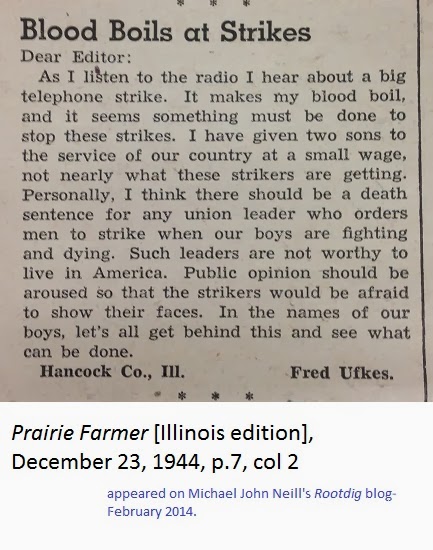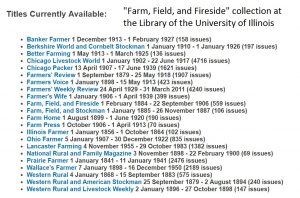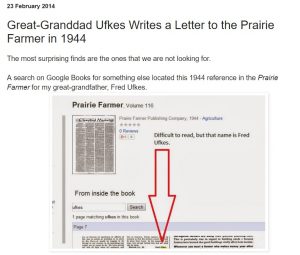
I was searching the issues of the Prairie Farmer that are online in the “Farm, Field, and Fireside” collection at the University of Illinois. I was not looking for anyone in particular. I searched for “ufkes” as I often do and failed to locate an item that I know I had found before involving my great-grandfather.
I knew it was from the Prairie Farmer and I knew it was my great-grandfather. I was positive. A search of my old blog posts located the reference from 1944 where my gr eat-grandfather has written a letter in reference to a telephone strike. I was correct about the fact he had written a letter. I was just certain that I had found it on the University of Illinois website.
eat-grandfather has written a letter in reference to a telephone strike. I was correct about the fact he had written a letter. I was just certain that I had found it on the University of Illinois website.
Turns out that I did not.
The initial screen inventory of the digital issues of the Prairie Farmer indicated that the time frame covered was 1841 to 1941. That’s technically correct, but a more detailed look at the inventory indicates that images for the years 1924-1940 are not available digitally on the site. There may be specific issues in other years that are missing as well. My search of the inventory did not continue further once I realized that 1944 was not included.
I went back to search my old blog posts and found another one about the clipping, “Great-Granddad Ufkes Writes a Letter to the Prairie Farmer in 1944.” This post explained how I had located the article and as soon as I read it I remembered more about my process. It was not by using the digital images of Prairie Farmer at the University of Illinois that the item was located. The reference was discovered by searching GoogleBooks and GoogleBooks did not have the entire image online. Memory cannot always be trusted.
search my old blog posts and found another one about the clipping, “Great-Granddad Ufkes Writes a Letter to the Prairie Farmer in 1944.” This post explained how I had located the article and as soon as I read it I remembered more about my process. It was not by using the digital images of Prairie Farmer at the University of Illinois that the item was located. The reference was discovered by searching GoogleBooks and GoogleBooks did not have the entire image online. Memory cannot always be trusted.
GoogleBooks probably did not have the entire image online due to copyright concerns. It was at that point that I remembered how I had obtained the actual image used for the blog post. It had been sent to me as a digital image by a reader who had actual access to paper copies of the magazine.
My citation for the 1944 newspaper clipping, while not quite formatted correctly does include the essential details. The image was made from an actual copy of the magazine. But there are two things that helped me get that image that are not included in the image:
- the fact that I received the image via email from someone with access to the actual magazine
- the fact that I discovered the reference in the first place via a search of GoogleBooks.
I realize there are some who think that search process is not a key element of a citation. I’m starting to think that sometimes it is and it really depends upon how the item was located. If I just include the publication information is that sufficient? Yes, it is sufficient to find that same letter in an issue of the Prairie Farmer from 1944.
But it does not address how I knew to look in that issue.
Or does that even matter?

3 Responses
Thank u, now I understand that important suggestion. That really makes sense.
I believe that sourcing items is to be done in such a way that ANYONE who reads the citation details would be able to locate that item. So…I would say that the source should include all of the information about how you found the item.
I’ve learned the hard way if I’ve found something so obscure or unexpected I need to make note of it with the item I found. And include it with the fact when I add it to my tree. I’ve had a few documents that I am sure my ancestor threw in my face because I would never have put it all together on my own. When I need to direct someone else to my conclusion I can refer them to the place where I found it and also to the supporting evidence which made me realize I had the right person. More than likely I had been curled into the fetal position by the time I found it. I did not want to return to that position when I couldn’t retrace my steps.